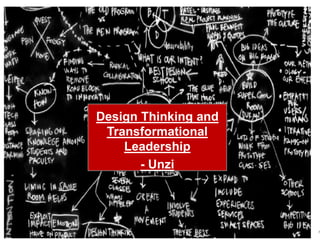
Design Thinking and Transformation Leadership.pptx
- 2. Design Thinking Design thinking is neither art nor science nor religion. It is the capacity, ultimately, for integrative thinking. – Tim Brown Design thinking is “a human- centered approach to innovation that draws from the designer’s toolkit to integrate the needs of people, the possibilities of technology, and the requirements for business success.” – Tim Brown 2
- 3. The Sweet Spot for Innovation Desirability - A desirable solution, one that your customer really needs Feasibility- A feasible solution, building on the strengths of your current operational capabilities Viability- A profitable solution, with a sustainable business model. The Sweet Spot for Innovation
- 4. An Introduction to Design Thinking Design is a process encourages participants to think outside the box in the pursuit of creative or innovative solutions. Design Thinking proposes a get- your-hands-dirty, learning-by- doing approach. Successful businesses are making billions by recognizing the value of integrating “design thinking” into their process. Design thinking shifts the focus from a business-centric engineering solution, to a customer-centric solution. 4
- 5. Steps in Design Thinking 5 Empathize-To create meaningful innovations, you need to know your users and care about their lives Define- Framing the right problem is the only way to create the right solution. Ideate- It’s not about coming up with the ‘right’ idea, it’s about generating the broadest range of possibilities. Prototype- Build to think and test to learn. Test- Testing is an opportunity to learn about your solution and your user.
- 6. Design Is A Process...
- 7. IDEO
- 8. Design Vs Design Thinking
- 9. 10 Principles of Design Thinking 10
- 11. Companies that Innovate Supply Chain and Inventory Management, food spectrometry to identify composition- Target Supermarket Social Good , Food and Design – Starbucks 12
- 12. Design Thinking Non-Denominational • not the sole domain of the designer or design manager • Practiced throughout the organization Means to Align • Internal culture aligns with the external brand offer, the enterprise is optimized for creativity, agility and efficacy. Means to Deliver Creativity • Customer-centric language to discuss the opportunities available to the organization Experiential • creates solutions from a user-need perspective rather than through the conventional approach of defining a potential market, and force-fitting solutions. Predictive Mechanism • fundamental ‘starting point’ of design thinking, the process itself can be a ‘hedge’ against the interruptive nature of technology and cultural shifts • start-ups like Airbnb
- 13. Transformational Leadership “For the past decade, research has supported the idea that, on average, transformational leadership is far more effective than transactional leadership in generating the higher levels of extra effort, commitment, performance, and satisfaction of those led.” Bruce J. Avolio, 1999 15
- 14. Two Types of “Leadership” 16 BASIS FOR COMPARISON TRANSACTIONAL LEADERSHIP TRANSFORMATIONAL LEADERSHIP Concept Leader lays emphasis on his relation with followers. Leader lays emphasis on the values, ideals, morals and needs of the followers. Nature Reactive Proactive Leader’s Source of power Rank, Position Character, Competence Works for Developing the existing organizational culture. Changing the existing organizational culture. Style Bureaucratic Charismatic How many leaders are there in a group? Only one More than One Focused on Planning Evaluation and Execution Innovation and Development Motivational tool Attracting followers by putting their own self interest in the first place. Stimulating followers by setting group interest as a priority. Supervision Important Less important Follower reaction Compliance Commitment Leader’s source of power Rank , position Character, Competence
- 15. The 4 Elements of Transformational Leaders Idealized Influence • The first element is to Be a Positive Role Model. • The leader serves as a positive role model for followers (“I want to be like my leader”). • The leader is admired because she or he “walks the talk” Inspirational Motivation • The second element is that Transformational leaders have the ability to inspire and motivate followers. • Combine this with Idealized Influence, and this is the source of the transformational leader's charisma. 17
- 16. The 4 Elements of Transformational Leaders Individualized Consideration • Transformational leaders demonstrate genuine concern for the needs and feelings of followers. • This personal attention to each follower is a key element in bringing out their very best efforts, and in developing the follower’s leadership potential. Intellectual Stimulation • The final element is the leader’s ability to challenge followers to be innovative and creative. • A common misunderstanding is that transformational leaders are "soft," but the truth is that they constantly challenge followers to higher levels of performance. 18
- 22. 24 Thank you
Notes de l'éditeur
- – in other words, the leader wouldn’t ask followers to do something that he or she wouldn’t do, and the leader never says one thing and does another.
- – in other words, the leader wouldn’t ask followers to do something that he or she wouldn’t do, and the leader never says one thing and does another.